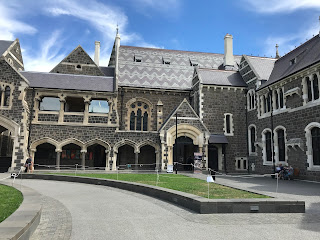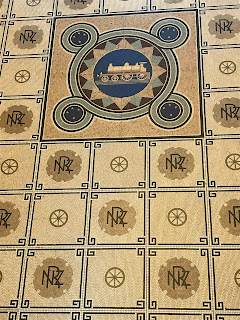The forecast was mixed for the next leg of our cruise. From our anchorage in Port Underwood, our path led southeast out of Cook Strait, around Cape Campbell, and down the east coast of the South Island to Lyttelton, Christchurch’s port. The promised westerly wind gave us a great run down the Strait, but, also as promised, once south of Cape Campbell, the South Island formed a wind shadow, blocking this wind. Oh, well. There are worse things at sea than motoring. Of course, the wind came up again just as we entered the harbour late the next afternoon — on the nose — giving us an upwind slog into twenty knots or so for the last few miles. Found a snug spot to anchor, though, caught up on sleep, and motored across the harbour into the new marina the next morning.
The new marina took us by surprise; it was only built some three years ago, so was not in the cruising guide. A very pleasant surprise, though — well protected inside the inner harbour, nice facilities, super friendly and helpful staff, and a short walk to town.
This was all new territory for us, both Lyttelton and nearby Christchurch, so as soon as we were settled in, off we went to explore. There is a high ridge separating Lyttelton and the harbour from Christchurch. It is penetrated by an automobile tunnel now, but the early settlers had to walk up and over via a steep track, dragging carts with all their goods. So, yes, of course, that’s what we did. Once. That was enough. After that, we happily took the bus, especially happy since it’s free for us geezers.
Christchurch is a nice city, but it is as flat as a pancake. I’m used to seeing at least some hills when I look up, but not here. It is a nice city, though, with lots of green space, walking areas, museums, etc. We thoroughly enjoyed a number of excursions there during our six-day stay. We especially enjoyed spending some time with Sue, one of Caroline Goodison’s sisters. Carolyn and Ian Goodison are our oldest and dearest friends in Whangarei — pretty much family — and we have always enjoyed meeting their siblings and parents. Even better was coffee one afternoon with not only Sue, but also Eloise, Carolyn and Ian’s daughter, here for school.
Christchurch has a lot of interesting architecture, both old and new. Much of the old was damaged or destroyed in the 2011 earthquake, and there is still much evidence of that event. Massive steel beams hold weakened walls in place, awaiting repair. The cathedral, an iconic centerpiece in the city, was severely damaged. Covering the gap where one whole wall fell is a tarp painted to look like the old wall. Nice touch, that.
Christchurch and Dunedin have a long history with Antarctic exploration; some of the most famous explorers left from here. Poking around The Arts Centre, a complex of 19th century Gothic Revival-style buildings, originally housing the University of Canterbury, we stumbled upon a very convincing replica of the “James Caird”. This was the small boat that was central to the survival of Sir Ernest Shackleton and his crew on their ill-fated attempt on the first crossing of Antarctica.
Sculpture in Central Christchurch
Just east of Lyttelton Harbour is the Banks Peninsula, jutting well out into the Pacific and deeply incised all around with numerous long, sinuous inlets. The largest of these inlets forms Akaroa Harbour, the site of a French attempt at colonization here in the mid-1800’s. It’s the oldest town in Canterbury, and one of the most historic towns in New Zealand. Frank Worsley, the captain of Shackleton’s ship, was born here. It was also a convenient stop on our way further south.
Refueling was inconvenient in Lyttelton, and the marina manager there had told us that Akaroa had a fuel pump on a floating pontoon, the usual (and convenient) marine arrangement, so we had deferred refueling till Akaroa. Turned out that the pump there was on a fixed wharf, seriously difficult for a yacht. You have to tie up to rough wooden pilings, eager to grind up topside paint, and maybe fibreglass, too! Add in wind and tide, and we don’t want to be there. Fortunately, there was a floating pontoon on the opposite side of the wharf where we could tie up easily and safely. A bit too far for the diesel hose, though, so we refueled by jerry jug, our only one, five gallons at a time.
There are only two places to escape weather in the 150 miles between Akaroa and Dunedin. The first, Timaru, is a small shipping port with no yacht facilities, really only useful to us in an emergency. The second is Oamaru, a man-made harbour formed by rock breakwaters. The guide book said the harbour entrance there was heavily silted in, narrow and shallow and only useable at fairly high tide. Didn’t sound good, but I called the local authorities for current information, learning that the entrance had been dredged the previous year, and was now plenty wide and deep enough at any tide. So, mostly because we knew nothing about Oamaru, we decided to stop there. After a disappointing downwind run on a sloppy sea in light wind (lots of uncomfortable rolling with the sails banging side to side), we happily dropped the hook and found an interesting, friendly town.
Oamaru was an important, wealthy shipping port in the Victorian period, and its beautiful old buildings reflect that. Many shops also maintain the Victorian theme in clothing and other products. Most of these old buildings were built with local limestone, a soft rock that lent itself to extensive, intricate carvings. One example of the friendliness we found there was that we hardly had the anchor down when a local fisherman offered us the use of his mooring in a calmer part of the basin than where we were anchored. He all but insisted that we use it.
Eager to move on just two days later, we slipped the mooring at first light to motor out, but something was wrong with the engine. It wouldn’t develop full power, and was blowing a lot of black smoke. Back to the mooring to check it out. Turns out we had some kelp tangled on the propeller. At first I thought I’d have to go for a swim to clear it, but a little revving, shifting back and forth, forward and reverse, chopped it free, so off we went again.
This time the wind was good, gradually building as we approached the entrance to Otago Harbour (Dunedin’s port), such that we came streaming in under reefed main and jib. The harbour is ten miles or so long, mostly very shallow but with a narrow, sinuous ship channel. The harbour is huge, wide as well as long, but there is precious little deep enough for a yacht outside the ship channel. One such spot is the Otago Yacht Club. They have an enclosed basin with pile moorings and a few floating pontoons, and they are very welcoming to visiting yachties. We had arranged for a berth there, but we needed to enter at near high tide for adequate depth between the ship channel and the basin. The land surrounding the harbour forms a venturi, so with the wind and tide behind us, and just a scrap of sail hoisted, we sailed up the harbour doing our best to slow down to let the tide rise a bit more. Successful at that, we dropped the sail and motored into the yacht club basin. All we knew was that we were aiming for a downwind landing at a pontoon with 25-30 knots of wind behind us. I had various contingency plans, but was not happy to see two yachts on either end of the pontoon, both protruding into our approach. There were many hands, though, waiting to help us moor, so it all turned out fine. Never any danger, really, just a bit of excitement. Actually, if no one had been there to help us, we would have just dropped the anchor to stop, and then used warps to pull us in sideways to the pontoon.
Two of the people waiting for us on the pontoon were Murray and Jennie Grimwood. They had come through Whangarei a few years ago on their return from Tonga. We saw them again a year or so ago at a wedding of mutual friends up north in the Bay of Islands. As was the case in Lyttelton, it is so nice to know people when you pull in somewhere. You don’t feel quite so much the stranger. Anyway, it doesn’t take long among yachties to make new friends, and here was no different. Julian and Kara on a neighboring boat had spent a little time in Whangarei just after we left last December, and had become friends with friends of ours there. We felt part of the community right off.
The yacht club is right at the edge of Dunedin, and we’ve been walking all over, visiting the parks and museums, the farmers market yesterday, a longer walk up to an overlook, etc. Dunedin also has some interesting architecture. The old railway station, in particular, is most impressive. It clearly reflects a time and place that had civic pride (and money to spend on it). Julian helped me fuel up, providing transport and enough jugs to do the job in one trip. Murray gave us a tour all around the Otago Peninsula (which forms the south side of the harbour), showing us a number of places not on the tourist maps, then took us home for dinner and a very nice evening.
From here, it’s about 160 miles to Stewart Island on the south side of Fouveaux Strait. That’s as far south as you can go and still be in New Zealand. There are no intermediate harbours between here and Stewart Island, and this is not a stretch of water to treat lightly, so we have been waiting here for a suitable weather forecast. At this point, Wednesday, it looks good for continuing south this Friday.














Hey Mark and Robyn! Just read your blog from going down east coast NZ. Wow, I'd say great adventure! You two find interests and beauty and good times wherever you go! I enjoy the writing....very good descriptions of all your movements. Can't wait to read about your adventures on and around Stewart Island.
ReplyDelete